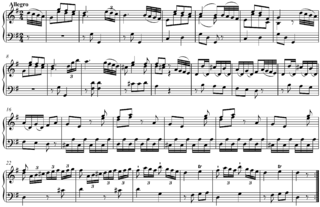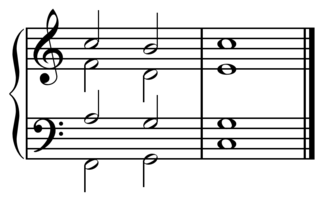A secondary development, in music, is a section that appears in certain musical movements written in sonata form. The secondary development resembles a development section in its musical texture, but is shorter and occurs as a kind of excursion within the recapitulation section.
Sonata form is a musical structure consisting of three main sections: an exposition, a development, and a recapitulation. It has been used widely since the middle of the 18th century.

In classical music, musical development is a process by which a musical idea is communicated in the course of a composition. It refers to the transformation and restatement of initial material. Development is often contrasted with musical variation, which is a slightly different means to the same end. Development is carried out upon portions of material treated in many different presentations and combinations at a time, while variation depends upon one type of presentation at a time.

In music theory, the recapitulation is one of the sections of a movement written in sonata form. The recapitulation occurs after the movement's development section, and typically presents once more the musical themes from the movement's exposition. This material is most often recapitulated in the tonic key of the movement, in such a way that it reaffirms that key as the movement's home key.
Contents
Charles Rosen, who has written extensively on the concept, presents the idea as follows:

Charles Welles Rosen was an American pianist and writer on music. He is remembered for his career as a concert pianist, for his recordings, and for his many writings, notable among them the book The Classical Style.
- The Secondary Development section appears in the great majority of late eighteenth century works soon after the beginning of the recapitulation and often with the second phrase. Sometimes it is only a few bars long, sometimes very extensive indeed. The purpose of this section is to lower harmonic tension without sacrificing interest: it introduces an allusion to the subdominant or to the related "flat" keys. [1]
The significance of the use of subdominant or similar harmony is related to Rosen's general views on sonata form, in which the exposition section creates a sense of musical tension by moving to the dominant key (which lies upward from the home key by one on the circle of fifths). This tension which is "resolved" in the recapitulation by the return to the tonic. [2] The use of the subdominant in secondary developments, a downward move from the tonic on the circle, provides a sort of balance. [3] As Rosen says, "it is the restoration of harmonic equilibrium as well as the need for variation that gives the Secondary Development its function." [4]

In musical form and analysis, exposition is the initial presentation of the thematic material of a musical composition, movement, or section. The use of the term generally implies that the material will be developed or varied.

In music theory, the circle of fifths is the relationship among the 12 tones of the chromatic scale, their corresponding key signatures, and the associated major and minor keys. More specifically, it is a geometrical representation of relationships among the 12 pitch classes of the chromatic scale in pitch class space.
Sometimes the secondary development serves a rather mechanical structural function. In a recapitulation, the musical material that was laid out in the exposition is restated so as to occur entirely (or almost so) in the main key. Thus some kind of alteration is needed to keep the music in the original key, at the spot that corresponds to the place in the exposition where the music changed key. Many secondary developments are placed where they can serve this function. [5] Rosen emphasizes, however, that facilitating the arrangement of keys is not the only or even primary function of a secondary development. As evidence he notes that "the Secondary Development as often as not returns to one of the themes of the first group, which necessitates a still further change later in the section in order to bring the second group into the tonic." [1] As an example Rosen cites Beethoven's "Waldstein" sonata, op. 53.
Beethoven's Piano Sonata No. 21 in C major, Op. 53, known as the Waldstein, is one of the three most notable sonatas of his middle period. Completed in summer 1804 and surpassing Beethoven's previous piano sonatas in its scope, the Waldstein is a key early work of Beethoven's "Heroic" decade (1803–1812) and set a standard for piano composition in the grand manner.
The secondary development sometimes forms a passage of great drama, even the dramatic climax of the movement. For one such instance, see Rosen's discussion of the secondary development in the opening movement of Haydn's string quartet in B minor, Op. 33 no. 1. [6]

(Franz) Joseph Haydn was an Austrian composer of the Classical period. He was instrumental in the development of chamber music such as the piano trio. His contributions to musical form have earned him the epithets "Father of the Symphony" and "Father of the String Quartet".







